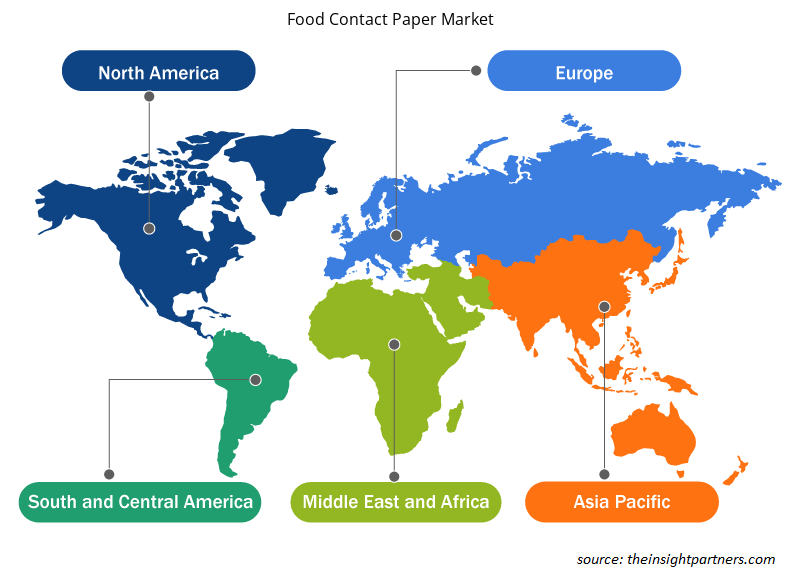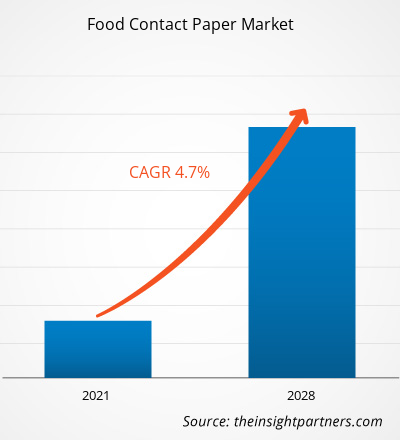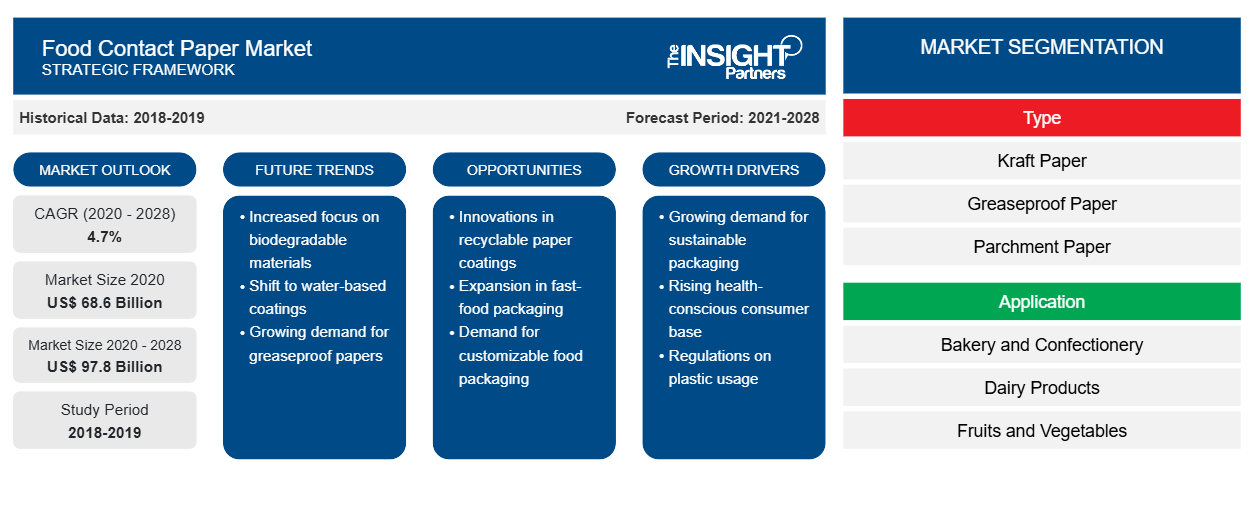El mercado de papel en contacto con alimentos se valoró en 68.600 millones de dólares en 2020 y se proyecta que alcance los 97.800 millones de dólares en 2028; se espera que crezca a una CAGR del 4,7% entre 2021 y 2028.
Los papeles en contacto con alimentos se utilizan como material de envasado primario para diversos productos alimenticios, como alimentos horneados, dulces, carnes, bocadillos y productos de molienda de cereales. Los papeles son alternativas sostenibles a muchos otros materiales de envasado de alimentos, como el plástico y el vidrio. Las crecientes iniciativas de las empresas para reducir su huella de carbono están influyendo en la adopción de papel en contacto con alimentos en todo el mundo. El aumento de la demanda de envases de alimentos sostenibles y ecológicos también ha aumentado la demanda de envases de papel para alimentos.
En 2020, Asia Pacífico dominó el mercado mundial de papel para contacto con alimentos y se espera que continúe su dominio durante el período de pronóstico. Se espera que la creciente industria de servicios de alimentos en los países asiáticos, la creciente conciencia sobre el medio ambiente y el aumento de las iniciativas gubernamentales para prohibir los envases de plástico en varios países asiáticos aceleren la demanda de soluciones de embalaje ecológicas y sostenibles, lo que impulsaría el crecimiento del mercado de papel para contacto con alimentos en Asia Pacífico.
Personalice este informe según sus necesidades
Obtendrá personalización en cualquier informe, sin cargo, incluidas partes de este informe o análisis a nivel de país, paquete de datos de Excel, así como también grandes ofertas y descuentos para empresas emergentes y universidades.
- Obtenga las principales tendencias clave del mercado de este informe.Esta muestra GRATUITA incluirá análisis de datos, desde tendencias del mercado hasta estimaciones y pronósticos.
Muchas industrias, como la industria química y de materiales, se enfrentaron a desafíos sin precedentes debido a la pandemia de COVID-19. Debido a la escasez de materia prima y mano de obra, el cierre de fábricas y otras dificultades operativas bajo los protocolos de seguridad de COVID-19, los fabricantes de productos de embalaje enfrentaron una contracción en las ventas durante los meses iniciales de la pandemia. Además, el cambio en el estilo de vida de los consumidores y sus cambiantes patrones de alimentación han reducido el consumo de alimentos listos para usar y de exterior debido a la propagación del virus, lo que ha afectado negativamente a la demanda de papeles de contacto con alimentos. Sin embargo, como varios países están levantando el bloqueo con las medidas de precaución adecuadas, es probable que la demanda de papeles de contacto con alimentos vuelva a encarrilarse. A medida que se impuso el bloqueo en varios países, el sector del comercio electrónico fue testigo de una demanda significativa de varios productos, como alimentos envasados y comestibles, incluidas verduras y frutas frescas, debido al cierre de las tiendas físicas, lo que impulsó la utilización de papeles de contacto con alimentos.
Perspectivas del mercado
Demanda en aumento de soluciones de embalaje reciclables y biodegradables
Los envases biodegradables y reciclables han sido una alternativa atractiva a las opciones de envases de un solo uso tanto para los consumidores como para los fabricantes. Los envases de servicios alimentarios generan una cantidad significativa de residuos en los vertederos de los EE. UU. Según un informe publicado por la Agencia de Protección Ambiental de los Estados Unidos, los residuos y envases de alimentos representan la mayoría de los materiales que se vierten en los vertederos de los EE. UU. Dado que los envases de papel son biodegradables, se prefieren a los envases reciclables. El uso de envases de alimentos reciclados aumenta las posibilidades de contaminación, lo que puede afectar potencialmente al medio ambiente y la salud humana. Las crecientes iniciativas de los gobiernos de todo el mundo sobre el uso de bolsas de plástico de un solo uso están impulsando la demanda de soluciones de envasado que sean reciclables y, al mismo tiempo, sostenibles, lo que genera una mayor demanda de papeles en contacto con alimentos.
Tipo de información
Según el tipo, el mercado de papel en contacto con alimentos se segmenta enPapel kraft, papel resistente a la grasa, papel pergamino y otros. El segmento de papel kraft tuvo la mayor participación de mercado en 2020. Los papeles kraft naturales tienen fibras vírgenes puras, lo que los convierte en una solución ideal para el envasado en contacto con alimentos. El papel se utiliza cada vez más para fabricar diversos productos de papel en contacto con alimentos, como bolsas de papel, sacos de papel, papel de regalo y platos de papel. El papel kraft natural también se utiliza cada vez más para fabricar bolsas de supermercado para frutas y verduras frescas debido a su alta resistencia.
Mondi; Westrock Company; Georgia-Pacific LLC; Twin River Paper Company; UPM; Ahlstrom-Munksjö; GM Packaging (UK) Ltd; Superiorpaper Pty Ltd. TopCare; y KRPA Holding CZ, entre otros, se encuentran entre los actores clave que operan en el mercado del papel para contacto con alimentos. Los principales actores del mercado están adoptando estrategias como fusiones y adquisiciones y lanzamientos de productos para expandir su presencia geográfica y su base de consumidores.
Informe Destacado
- Tendencias progresivas en la industria del papel en contacto con alimentos que ayudarán a los actores a desarrollar estrategias efectivas a largo plazo
- Estrategias de crecimiento empresarial adoptadas por las empresas para asegurar el crecimiento en los mercados desarrollados y en desarrollo
- Análisis cuantitativo del mercado mundial de papel en contacto con alimentos de 2019 a 2028
- Estimación de la demanda de papel en contacto con alimentos en diversas industrias
- Análisis de Porter para ilustrar la eficacia de los compradores y proveedores que operan en la industria para predecir el crecimiento del mercado
- Desarrollos recientes para comprender el escenario competitivo del mercado y la demanda de papel en contacto con alimentos
- Tendencias y perspectivas del mercado junto con los factores que impulsan y restringen el crecimiento del mercado del papel en contacto con alimentos
- Comprensión de las estrategias que sustentan el interés comercial en relación con el crecimiento del mercado mundial de papel en contacto con alimentos, lo que ayuda en el proceso de toma de decisiones.
- Tamaño del mercado de vidrio flotado en varios nodos del mercado
- Descripción detallada y segmentación del mercado mundial de papel en contacto con alimentos, así como su dinámica industrial
- Tamaño del mercado de papel de contacto con alimentos en varias regiones con oportunidades de crecimiento prometedoras
Perspectivas regionales del mercado de papel en contacto con alimentos
Los analistas de Insight Partners explicaron en detalle las tendencias regionales y los factores que influyen en el mercado de papel en contacto con alimentos durante el período de pronóstico. Esta sección también analiza los segmentos y la geografía del mercado de papel en contacto con alimentos en América del Norte, Europa, Asia Pacífico, Oriente Medio y África, y América del Sur y Central.

- Obtenga datos regionales específicos para el mercado de papel en contacto con alimentos
Alcance del informe de mercado de papel para contacto con alimentos
| Atributo del informe | Detalles |
|---|---|
| Tamaño del mercado en 2020 | US$ 68,6 mil millones |
| Tamaño del mercado en 2028 | US$ 97.8 mil millones |
| Tasa de crecimiento anual compuesta (CAGR) global (2020-2028) | 4,7% |
| Datos históricos | 2018-2019 |
| Período de pronóstico | 2021-2028 |
| Segmentos cubiertos | Por tipo
|
| Regiones y países cubiertos | América del norte
|
| Líderes del mercado y perfiles de empresas clave |
|
Densidad de actores del mercado de papel en contacto con alimentos: comprensión de su impacto en la dinámica empresarial
El mercado de papel para contacto con alimentos está creciendo rápidamente, impulsado por la creciente demanda de los usuarios finales debido a factores como la evolución de las preferencias de los consumidores, los avances tecnológicos y una mayor conciencia de los beneficios del producto. A medida que aumenta la demanda, las empresas amplían sus ofertas, innovan para satisfacer las necesidades de los consumidores y aprovechan las tendencias emergentes, lo que impulsa aún más el crecimiento del mercado.
La densidad de actores del mercado se refiere a la distribución de las empresas o firmas que operan dentro de un mercado o industria en particular. Indica cuántos competidores (actores del mercado) están presentes en un espacio de mercado determinado en relación con su tamaño o valor total de mercado.
Las principales empresas que operan en el mercado de papel en contacto con alimentos son:
- Mundo
- Compañía Westrock
- Georgia-Pacific LLC
- Compañía de papel Twin River
- UPM
Descargo de responsabilidad : Las empresas enumeradas anteriormente no están clasificadas en ningún orden particular.

- Obtenga una descripción general de los principales actores clave del mercado de papel en contacto con alimentos
Mercado de papel para contacto con alimentos, por tipo
- Papel Kraft
- Papel a prueba de grasa
- Papel pergamino
- Otros
Mercado de papel para contacto con alimentos, por aplicación
- Panadería y Confitería
- Productos lácteos
- Frutas y verduras
- Carne, pescado y aves de corral
- Otros
Perfiles de empresas
- Mundo
- Compañía Westrock
- Georgia-Pacific LLC
- Compañía de papel Twin River
- UPM
- Ahlström-Munksjö
- GM Packaging (Reino Unido) Ltd.
- Superiorpaper Pty Ltd
- Cuidado superior
- KRPA Holding CZ, como
- Análisis histórico (2 años), año base, pronóstico (7 años) con CAGR
- Análisis PEST y FODA
- Tamaño del mercado, valor/volumen: global, regional y nacional
- Industria y panorama competitivo
- Conjunto de datos de Excel
Informes recientes
Informes relacionados
Testimonios
Razón para comprar
- Toma de decisiones informada
- Comprensión de la dinámica del mercado
- Análisis competitivo
- Información sobre clientes
- Pronósticos del mercado
- Mitigación de riesgos
- Planificación estratégica
- Justificación de la inversión
- Identificación de mercados emergentes
- Mejora de las estrategias de marketing
- Impulso de la eficiencia operativa
- Alineación con las tendencias regulatorias























 Obtenga una muestra gratuita para - Mercado de papel en contacto con alimentos
Obtenga una muestra gratuita para - Mercado de papel en contacto con alimentos